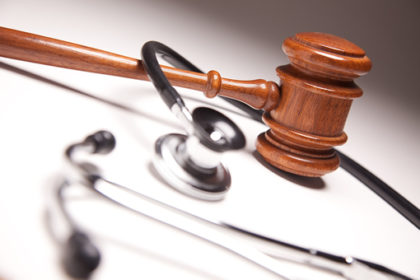
Medical Negligence – How to take action
Unfortunately things do go wrong. We may have a case of medical negligence in the Maternity services at a Galway hospital. It became the latest to be probed following the deaths of two babies and oxygen deprivation to five others. Figures released by the HSE on the 9th of October 2012 showed 85,918 adverse clinical medical incidents in 2011. This means that there were 235 errors every 24 hours, which is the equivalent to 1 error every six minutes.
[soundcloud id=190949742]Why do people contact a Solicitor?
The medical profession is held in high esteem. Huge trust is placed in a health professional when you submit yourself for an operation or even when you hold out your arm to receive an injection.
When things go wrong the reaction of an injured patient or their family is an emotional one: there is a strong sense of the breach of this trust.
I find that injured patients hire Solicitors, not because of the desire to obtain compensation, but instead they are driven by a lack of knowledge about what happened to them, the inability to get answers and the desire to get an apology. In many cases we achieve compensation for Clients with an apology.
There is a perception amongst injured patients and their families that when something goes wrong, the medical profession closes ranks and they cannot get straight answers to the straightforward questions.
Are these types of cases very difficult?
Unlike with other types of personal injuries, medical negligence cases are very complex. In a lot of cases, the person is sick before they ever get to hospital, or they are suffering from a serious underlying condition, such as cancer and one of the tasks which the Solicitor faces is to distinguish what the outcome would have been but for the negligent act or omission
which took place.
Inevitably, the Defendants will argue that the illness or disease that the person had when they submitted themselves for treatment was the determining factor in the final outcome or, in the context for instance of a surgical treatment, that the injury complained of is within the realm of acceptable error :“ a recognised complication”.
Another difficulty is the lack of knowledge: when somebody gets injured in a factory, or is in an accident on the road, what led to the event is rarely in dispute. However, in a medical context, the background of the facts can be so vast and complex, that very often it is difficult to understand what happened.
Another problem is that medical negligence cases are still David v Goliath type challenges. They involve you (an individual) taking on the State which has deeper pockets and no emotional stake in the outcome.
How would someone know if there has been an act of Medical Negligence?
It is very difficult to establish at an early stage. It is not common for hospitals to inform patients when an error has occurred so typically a patient or relative becomes suspicious of an error, an uninformed opinion is formed we are then instructed to investigate.
What initial steps do you take to establish a possible case or “cause of action”?
Medical negligence claims, in a similar way to personal injury claims, are made up of a series of hurdles. If you do not clear the first hurdle you cannot move on to the next.
- Take up copies of all medical records and check them. In some cases we may even send them to a medical records expert for analysis;
- Write to the doctor, health care professional or institution we believe is responsible for the injuries caused;
- Medical experts specialising in the particular area of medicine involved will then be asked to consider whether or not the treatment received was negligent or substandard and if so the extent of the damage it caused.
- If we consider that we have enough evidence to prove a case of medical negligence, then we advise starting court proceedings immediately.
- Clinical negligence cases can be settled by negotiation without the need to proceed to a full trial but they are rarely resolved without starting court action.
It is a fact that things do go wrong with surgery and there may not necessarily be
negligence – how do the Courts decide what is and what is not negligence?
Medical Negligence is essentially an act or omission by a health care professional which is
below the accepted standard of care and which results in injury or death to a patient.
Interestingly, before the 1950s there was no reported case of medical negligence in Ireland.
In fact, until 1989 the number of cases was minimal.
In 1989 the case of Dunne v The National Maternity Hospital [1989] Irish Reports 91 came
before the Supreme Court and remains to be the influential case in medical negligence to
the present day. The facts of this case was that only one heartbeat was monitored during
pregnancy, despite the fact that the mother was pregnant with twins; this led to one twin
being delivered with severe brain damage, and the other being delivered dead.
These principles are very lengthy and too lengthy to discuss here but in summary you have
to prove that the care you received fell below medically acceptable standards. Acceptable
General and approved practice’ need not be universal but must be approved of and adhered
to by a substantial number of reputable practitioners holding the relevant specialist or
general qualifications.
What types of cases do you come across?
Medical Negligence can happen because of:
- Diagnosis – i.e. misdiagnosis or delayed diagnosis;
- Treatment – i.e. errors in the medical treatment such as incorrect medication, surgical
errors, exposure to infection (MRSA etc.) or;
During the last 30 years the office has probably dealt with most types of medical negligence.
We have dealt with a broad range of medical negligence cases over the years. We have
represented clients in the areas of cancer misdiagnosis, orthopaedic and surgical negligence,
failure to diagnose, cerebral palsy and neonatal claims, amongst others.
We are currently representing a significant number of people who have been affected by the
DePuy hip implant recall and narcolepsy arsing out of the swine flu vaccine.
Is there a time period for bringing these cases?
The Statute of Limitations (Amendment) Act 1991 introduced the ‘date of knowledge’ for
personal injury cases. The date of knowledge is applied when the date the wrong/injury takes
place differs from the date the wrong/injury is discovered. This means that in situations where
the injury may not be obvious at first the time limit for actions does not begin until the injured
party is aware of the injury.
While, generally speaking, a person has two years to make a claim for medical negligence,
the date of knowledge has been applied in medical negligence cases. A person who receives
a negligent medical procedure may not have knowledge of the injury at first until the injuries
cause problems or they become aware that such problems arose as a consequence of such
procedures. The ‘date of knowledge’ ensures that the time limit does not run out before a
person realises they have an injury/action.

